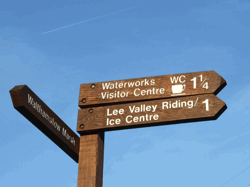3.1 Historical development
The River Lea, along with the River Fleet, is second only to the Thames, as the oldest
of London's waterways. The Danes sailed up the River Lea in the late C9th to sack
Hertford, and since the early C13th the River has been used regularly for the
transportation of goods into and out of the capital. Navigation along the River Lea has
been continually improved throughout its history; many of the improvements being
sanctioned by Acts of Parliament and funded through tolls. Improvements to the River
took the form of dredging, removing obstacles from the waterway, and cutting new
channels and locks. Flood relief channels were also constructed. Warehouses and
wharfs were built on the banks of the River, although in many areas it retained its
open rural character. Improvements continued until as recently as the 1930s, and
even as recently as the 1960s the River was used regularly for the transportation of
goods, such as timber and coal. There are few remaining timber-yards on the banks of
the River, and any that remain are now supplied by road transport.
|
